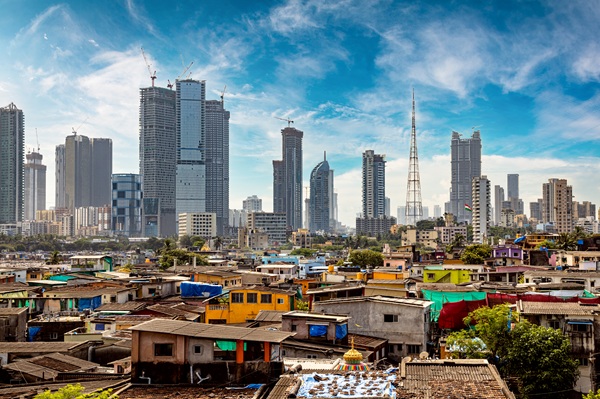.png)

Dhananjay Sinha, CEO and Co-Head of Institutional Equities at Systematix Group, has over 25 years of experience in macroeconomics, strategy, and equity research. A prolific writer, Dhananjay is known for his data-driven views on markets, sectors, and cycles.
July 9, 2025 at 3:41 AM IST
India’s government claims that inequality has fallen to among the lowest in the world, boasting policies that make the country the fourth most equal society globally. It points to a World Bank estimate suggesting a Gini coefficient of 25.5 in 2022-23, trailing only Slovakia, Slovenia, and Belarus.
This narrative is more convenient myth than economic fact. It rests on a selective interpretation of data, conflating consumption and income inequality while ignoring deeper structural problems. By highlighting a fall in consumption inequality drawn from the Household Consumption Expenditure Survey of 2022-23, the government is presenting a misleading picture of economic equality.
Consumption inequality measures differences in spending, often smoothed by state support and credit. Income inequality, by contrast, tracks how earnings themselves diverge. The government’s own data sources show that income inequality has worsened over the past two decades. Estimates suggest India’s Gini coefficient for income rose from 52 in 2004 to 62 in 2023, placing it among the world’s more unequal economies.
The government press release cited the World Bank without noting its clear caveats. Methodological changes in the consumption survey between 2011-12 and 2022-23 mean the data are not directly comparable. The latest survey used multistage visits, unlike the single-visit approach of the earlier round, complicating any claims of a significant decline in inequality.
Even within this flawed comparison, real per capita consumption has grown modestly over the past decade, with rural areas seeing just 3.3% compounded annual growth and urban areas 2.8%. This lags far behind the headline real gross domestic product growth of over 6%, suggesting consumption deceleration and potential distress among households.
Real incomes offer clearer evidence of strain. Reserve Bank of India KLEMS data show that real income per unit of labour input has slowed to below 4% average annual growth since 2018-19, from over 8% in the decade before. Employment has risen by 5.4% over this period, yet income per worker has contracted by 1.6% a year, the weakest performance since the late 1980s. The Periodic Labour Force Survey reveals that real incomes declined in around 80% of India’s states over the last five years, with stagnant rural wages, strained urban employment, and an overreliance on low-quality self-employment, especially among rural women.
Tax data confirm that formal-sector inequality is rising. Salaried workers have seen post-pandemic income growth averaging only 4.5% in 2023-24, with a ten-year average barely keeping pace with inflation. Inequality among this group has hit decade highs, with the share of income going to the bottom 40% falling from 15.5% in 2018-19 to 13.6% in 2023-24. The top 20% increased their share from 44.7% to 50% over the same period.
These trends reflect a broader economic shift—away from transformation, toward stagnation. Ruralisation is increasing as better-quality urban jobs fail to materialise. Migration has slowed, signalling reduced opportunities in cities. Industrial policy, while aiming to boost manufacturing, too often favours oligopolies and capital-intensive production that generates limited employment.
KLEMS data reveal labour displacement, with workers pushed back into low-productivity agriculture despite 4.7% annual growth in farm output. Real wages in agriculture have actually fallen by 0.6% annually, showing that growth is not translating into higher incomes for the rural workforce.
Meanwhile, the overall recovery remains uneven and K-shaped. Affluent households have benefited from productivity gains and booming equity markets. Lower-income households, by contrast, face tighter budgets, evident in declining consumption of staples and entry-level goods.
Welfare Trade-off
The government’s shift in strategy, from supply-side reforms meant to spur private investment to large-scale welfare spending, has failed to address these structural problems. While cash transfers, free food programmes, and other subsidies have provided some relief, they have also fuelled a rising public debt burden now estimated at around ₹280 trillion.
This growing debt is not translating into durable income gains. Instead, it masks distress by supporting consumption temporarily without fostering the investment needed for sustained job creation and productivity growth. By celebrating limited consumption gains as evidence of reduced inequality, the government risks obscuring the urgent need for genuine reforms.
The challenge is not just academic. Rising inequality amid stagnating real incomes weakens productivity, erodes incentives to work and invest, and ultimately limits the economy’s growth potential. It also risks fuelling social tensions as large sections of the population see their hopes for upward mobility dim.
A more honest approach would acknowledge the shortcomings in employment, income distribution, and productivity, and focus on reforms that can deliver broad-based growth. This means supporting labour-intensive industries, easing barriers for small firms, investing in education and health, and designing social protection that does not disincentivise work.
India’s growth story remains impressive in many ways, but the official claim of being one of the world’s most equal societies is not among them. Until real incomes rise across the board, narrowing the gap between consumption and income inequality, the myth of India as an equal society will remain just that—a myth.




